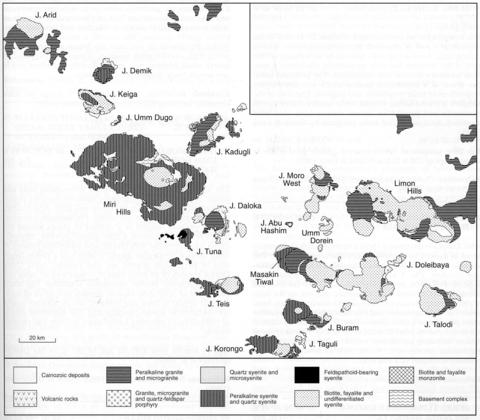stripes
Jebel Talodi is an approximately circular, rugged massif rising to over 600 m and covering some 90 km2. Precambrian basement rocks are well exposed in the east and consist of granitic and dioritic gneisses which are cut by felsic dykes. The complex is formed of three intrusive units the earliest being a quartz syenite on the eastern margin. This is variable in alkalinity some facies containing a non-alkaline clinopyroxene plus calcic-sodic amphibole, while others include sodic amphibole. A late peralkaline granite is chilled against the syenite and varies from an aegirine to a sodic amphibole granite; accessories include fluorite and zircon. The youngest, and by far the largest intrusion, is another quartz syenite which, like the earlier intrusion, is variable in mineralogy but aenigmatite, fayalite and a little biotite are present.
BATYRMURZAEV, A.S., TROFIMOV, N.N., SHAKHPAZOV, I.M., AHMED, F., KHALIL, B.E., ZAKIEVA, F.S., GADZLIIEO, S.Z. and SLYMAEV, A.A. 1982. The absolute age of minerals in certain Sudanese provinces. In: Mobile belts and deposits. A collection of scientific papers, Academy of Sciences, Moscow. Patrice Lumumba University: 30-6. CURTIS, P. and BRINKMANN, K. 1985. The geology of younger intrusive alkali complexes in the southwestern Nuba Mountains, Sudan. Geologisches Jahrbuch, 63: 3-41.

